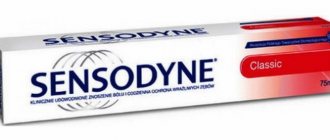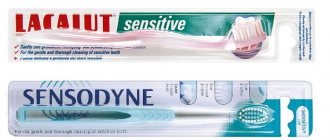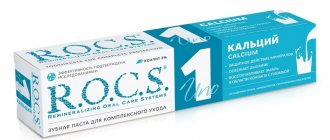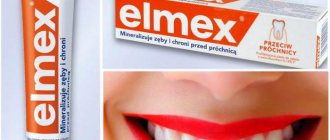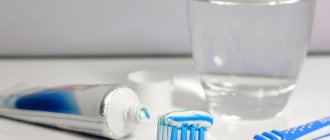From this article you will learn:
- causes of hypersensitivity of human teeth,
- best toothpaste for sensitive teeth,
- analysis of paste compositions, rating 2022.
Toothpaste can act not only as a means for cleaning teeth, but also, thanks to the inclusion of a number of active ingredients, help reduce tooth hypersensitivity, relieve inflammation in the gums, and also help strengthen tooth enamel. With increased tooth sensitivity, pain usually occurs in response to thermal and mechanical stimuli - cold, hot, when touching the teeth with a toothbrush, and sometimes even from sweets.
In most cases, this problem can be solved at home, using special toothpastes for sensitive teeth, as well as by applying gels containing one of the fluoride compounds to the necks of teeth. Pastes and gels from different manufacturers, due to their different compositions, differ in their effectiveness, and in this article we will analyze the composition of the most popular products for relieving hypersensitivity of tooth enamel.
Causes of hypersensitivity development –
First of all, this problem is associated with the thinning of the enamel layer in the area of the necks of the teeth, or with the exposure of the roots of the teeth and the thinning of the “cement” layer located on their surface.
As a result, a deeper layer of tooth tissue is exposed - dentin, which is located immediately under the enamel and cement. Dentin microscopically consists of dentinal tubes in which fluid circulates. If the dentin is not covered with enamel and cement on top, then thermal and other irritants can sharply increase the speed of fluid flow through the dentinal tubules, which ultimately leads to irritation of the nerve endings in the dental pulp and the occurrence of pain. The trigger for the development of pain (in the presence of dentin exposure) can be the consumption of acidic foods and drinks, the use of whitening toothpastes, etc.
Buy Sensodyne toothpaste Restoration and Protection of whiteness. 75ml in pharmacies
Sensodyne is the #1 recommended* brand by dentists for sensitive teeth. Exposed dentin causes increased tooth sensitivity. With Sensodyne Restoration and Protection Whitening toothpaste you have the opportunity to restore normal sensitivity. Sensodyne Restoration and Protection Whitening toothpaste forms a protective layer on the surface of sensitive areas of the teeth, similar in composition to natural tooth enamel. Use Sensodyne Restoration and Protection Whitening Paste 2 times a day to restore and protect teeth from sensitivity. At the same time, Sensodyne Restoration and Protection Whitening paste helps maintain the natural whiteness of teeth**.
* “Study of recommendations by dentists of various brands in the oral care segment”, Institute of Marketing Research GFK-Rus, November 2022 – January 2022.
** When brushing daily 2 times a day
Compound:
Glycerin, PEG-8, Hydrated Silica, Calcium Sodium Phosposilicate, (NOVAMIN), Cocamidopropyl Betaine, Sodium Methyl Cocoyl Taurate, Titanium Dioxide, Aroma, Carbomer, Sodium Fluoride, Sodium Saccharin, Limonene. Mass fraction of fluoride 0.145% F"" (1450 ppm). Contains sodium fluoride.
pharmachologic effect
Exposed dentin causes increased tooth sensitivity. With Sensodyne Restoration and Protection Whitening toothpaste you have the opportunity to restore normal sensitivity.
Sensodyne Restoration and Protection Whitening toothpaste forms a protective layer on the surface of sensitive areas of the teeth, similar in composition to natural tooth enamel. Use Sensodyne Restoration and Protection Whitening Paste 2 times a day to restore and protect teeth from sensitivity. At the same time, Sensodyne Restoration and Protection Whitening paste helps maintain the natural whiteness of teeth.
Indications for use
Daily dental and oral care.
Contraindications
Individual intolerance to components.
Carefully
If irritation occurs during use of the product, use of the paste should be discontinued.
Stop using the product and contact your dentist if:
Tooth sensitivity persists or worsens. Sensitive teeth may be a sign of a serious medical condition that requires immediate treatment from a dentist.
Tooth pain/sensitivity persists after 4 weeks of using the product.
Use during pregnancy and lactation
There are no contraindications to the use of toothpaste during pregnancy and lactation.
Directions for use and doses
Apply a pea-sized amount of toothpaste to a soft-bristled toothbrush.
Brush your teeth twice a day for 1 minute, but no more than three times, or as recommended by your dentist (attending physician). Try to brush all sensitive areas of your teeth more thoroughly. Do not swallow. Spit.
Side effect
Allergic reactions.
Release form
Paste in a tube of 75 ml, 1 tube in a cardboard package.
Storage conditions
Store in a dry place, out of reach of children, at a temperature not exceeding 30°C.
Best before date
2 years. Do not use after the expiration date.
How to choose a toothpaste for sensitive teeth -
Toothpastes for relieving tooth sensitivity (hypersthesia) have specific characteristics. Firstly, toothpaste for sensitive teeth usually has a fairly low abrasiveness within the RDA range of 25 to 35 (RDA - abrasiveness index). For example, for ordinary therapeutic and prophylactic toothpastes the RDA index is 75, and for whitening pastes it is usually 100-120.
The second important point to pay attention to is the active components. Different manufacturers use ingredients that are different from each other, which have different mechanisms for reducing tooth sensitivity, and as a result, have different effectiveness and different speed of onset of effect. Based on the mechanism of action, the following groups of components can be distinguished...
Active components in toothpastes for sensitive teeth -
- Potassium nitrate, potassium chloride - these components block the transmission of nerve impulses.
The transmission of nerve impulses is based on the exchange of potassium ions (located inside nerve cells) with sodium ions located outside the nerve. By increasing the concentration of potassium ions around the nerve endings, we disrupt this exchange, which leads to the absence of pain in the teeth - in response to thermal and mechanical stimuli. The advantage of these components is that the effect of their use develops very quickly. However, the result will last as long as you use them. Thus, potassium nitrate and chloride can quickly relieve pain, but they do not eliminate the very cause of hyperesthesia.
- Fluorides, strontium chloride, zinc citrate, hydroxyapatite - these components affect precisely the cause of the development of dental hypersensitivity - the accelerated movement of fluid in the dentinal tubules, which leads to irritation of the nerve endings.
Fluoride compounds (sodium fluoride, aminofluoride, monofluorophosphate), strontium chloride, zinc citrate, hydroxyapatite - all of them clog the dentinal tubules, preventing the movement of fluid in them. In addition, strontium chloride also promotes the deposition of replacement dentin and the compaction of its structure, which also helps reduce hypersensitivity. However, the downside of all these components is that the effect from their use develops more slowly than from the use of potassium nitrate or potassium chloride.
- Arginine and calcium carbonate combination - a combination of Arginine (an amino acid) and calcium carbonate in toothpaste - is also very effective in treating dental hypersensitivity.
Arginine facilitates the deposition of a layer of calcium carbonate on the surface of the teeth, which in turn stimulates the deposition of phosphates on the surface of exposed dentin and in the dentinal tubules, contributing to their clogging and reducing the movement of fluid in them. However, although it reduces sensitivity well, it does not solve the problem of demineralization of enamel and dentin. It should be noted here that the layer of calcium carbonate with arginine will be inactive, and calcium from this layer will not penetrate into the hard tissues of the teeth. This distinguishes arginine carbonate pastes from pastes with fluorides, after the use of which an active layer of calcium fluoride (CaF2) is created on the tooth surface. In addition to the fact that CaF2 also clogs the dentinal tubules on the surface of exposed dentin, calcium and fluoride from this layer are able to penetrate into the hard tissues of the teeth, strengthening them.
Conclusions -
Precisely because some components are capable of providing an immediate effect, while others (although their effect develops slowly, they eliminate precisely the cause of pain) - most toothpastes for sensitivity are made with a combined composition. Where potassium nitrate quickly relieves pain, and fluorides, hydroxyapatite, strontium chloride, or a combination of arginine and calcium carbonate clog exposed dentinal tubules.
However, there are also effective monocomponent products for use at home. Such products contain a very high concentration, usually of only one component, for example, potassium nitrate or sodium fluoride. In this way, they resemble professional means for reducing sensitivity that dentists use in their work. Examples of such gels are PRESIDENT Sensitive Plus and Colgate® Duraphat. How they can help you - read below.
Recommendations for use
It is important not only to choose the right paste, but also to use it correctly. To do this, you need to consult a dentist, who will examine the oral cavity and give appropriate recommendations. There are rules that must be followed:
- Do not expect a quick and strong effect from using toothpaste. It is necessary to brush your teeth daily for at least a week until you get the first results;
- When brushing your teeth, the paste should not be washed off immediately, but held on for a while so that the effect is stronger;
- You should not constantly brush your teeth with special toothpastes. The paste does not clean the stone 100%, as it has a low level of abrasiveness;
- The product has an analgesic effect, and you can easily miss the signs of emerging pathology in the oral cavity;
- Limit sour foods.
Toothbrushes for sensitive teeth –
In cases where the touch of the toothbrush bristles to the necks of the teeth causes pain and discomfort, it is recommended to use special toothbrushes with soft bristles when brushing your teeth. These brushes are marked “Soft”. They also differ from ordinary toothbrushes in that each bristle has a rounded or very thin atraumatic tip.
Price for toothbrushes for sensitive teeth –
- SENSODYNE Sensitive toothbrush – from 160 rubles,
- LACALUT Sensitive toothbrush – from 190 rubles.
Important: use this brush only in cases where pain occurs when touching your teeth with a regular toothbrush. They cannot be used on an ongoing basis, because... Brushes with soft bristles remove microbial plaque from teeth much worse than brushes with medium hardness, and therefore, with prolonged use, plaque and tartar may accumulate on the teeth.
Sensodyne Restoration and Protection, toothpaste for sensitive teeth 75ml
A country
Great Britain, Slovakia, United Kingdom
Country of origin may vary depending on product batch. Please check with the operator for detailed information when confirming your order.
Description
Sensodyne is the #1 recommended* brand by dentists for sensitive teeth. Sensodyne Restore & Protect Toothpaste restores sensitive areas of teeth and provides long-lasting protection against hypersensitivity**. Thanks to Novamin technology and sodium fluoride, a layer is formed on the surface of sensitive areas of the teeth, similar in structure to tooth enamel, which protects against painful sensations. Sensodyne Restore & Protect provides effective, long-lasting reduction in the incidence of tooth sensitivity* and provides daily protection against tooth decay. * “Study of recommendations by dentists of various brands in the oral care segment”, Institute of Marketing Research GFK-Rus, November 2022 – January 2018 **When brushing 2 times a day
Compound
Glycerin, PEG-8, Hydrated Silica, Calcium Sodium Phosposilicate, (NOVAMIN), Cocamidopropyl Betaine, Sodium Methyl Cocoyl Taurate, Titanium Dioxide, Aroma, Carbomer, Sodium Fluoride, Sodium Saccharin, Limonene. Mass fraction of fluoride 0.145% F"" (1450 ppm). Contains sodium fluoride.
Product description
Toothpaste.
pharmachologic effect
Thanks to Novamin technology and sodium fluoride, a layer is formed on the surface of sensitive areas of the teeth, similar in structure to tooth enamel, which protects against painful sensations. Sensodyne Restore & Protect provides effective, long-lasting reduction in the incidence of tooth sensitivity and provides daily protection against tooth decay.
Indications for use
Daily dental and oral care.
Contraindications
Individual intolerance to components.
Carefully
If irritation occurs during use of the product, use of the paste should be discontinued. Stop using the product and contact your dentist if: Tooth sensitivity persists or worsens. Sensitive teeth may be a sign of a serious medical condition that requires immediate treatment from a dentist. Tooth pain/sensitivity persists after 4 weeks of using the product.
Use during pregnancy and lactation
There are no contraindications to the use of toothpaste during pregnancy and lactation.
Directions for use and doses
Apply a pea-sized amount of toothpaste to a soft-bristled toothbrush. Brush your teeth twice a day for 1 minute, but no more than three times, or as recommended by your dentist (attending physician). Try to brush all sensitive areas of your teeth more thoroughly. Do not swallow. Spit.
Side effect
Allergic reactions.
Release form
Paste in a tube of 75 ml, 1 tube in a cardboard package.
Storage conditions
Store in a dry place, out of reach of children, at a temperature not exceeding 30 C.
Best before date
2 years. Do not use after the expiration date.
